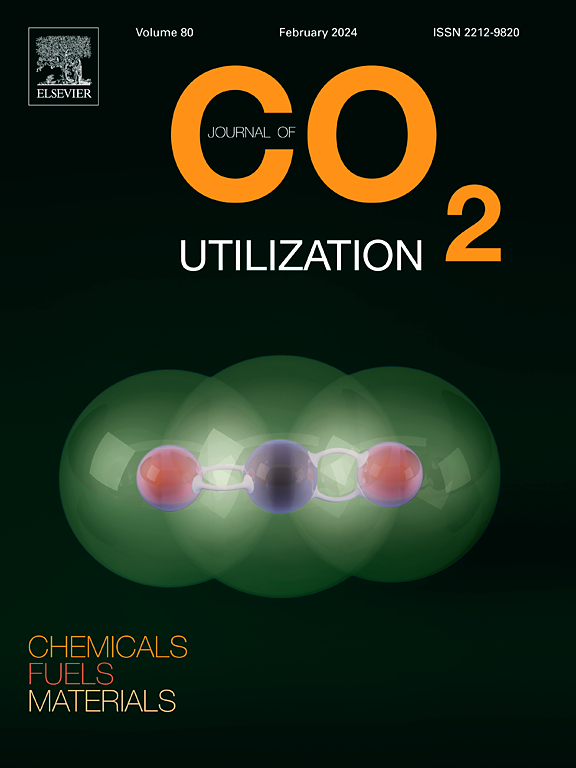3d打印金属支撑的旋转Ni/Al2O3 CO2甲烷化催化剂
IF 8.4
2区 工程技术
Q1 CHEMISTRY, MULTIDISCIPLINARY
引用次数: 0
摘要
3d打印在二氧化碳甲烷化催化剂生产中的应用已经出现,以应对高放热反应和高气体空间速度所带来的挑战,这些条件需要在保持最佳催化性能的同时增强传热和传质。在这项工作中,我们开发了一种新的二氧化碳甲烷化催化剂,该催化剂由Ni/Al2O3粉末涂层3d打印的旋转结构铝合金组成。采用选择性激光熔融(SLM)技术对金属合金AlMgSi进行3d打印(3DAL),并在其表面涂覆Ni/Al2O3粉末。显微镜和断层扫描技术用于检查催化剂的形态特征和分析内部拓扑结构,氢温度程序还原(H2-TPR)和化学吸附提供了还原位点和活性金属相的见解。采用CO2:H2:He气体混合物(1:4:5),在250°C ~ 500°C的不同温度下,通过CO2甲烷化实验来评估催化性能。3d打印的Ni/Al2O3-3DAL催化剂在400℃时具有较高的CH4选择性(97.7% %)和CO2转化率(77.6% %),这是由于金属载体降低了烧结倾向和有效的传热。3d打印的陀螺仪金属支架提供了更高的表面积体积比,从而提高了单位体积的催化剂负载,并且与粉末相比,改善了反应物与活性催化剂相的接触,从而提高了催化性能。它还提供了增强的热能管理和散热,这对于二氧化碳甲烷化等高度放热反应至关重要,而且与传统的珠状和颗粒状相比,它的机械强度也有所提高。本文章由计算机程序翻译,如有差异,请以英文原文为准。
A 3D-printed metal-supported gyroid Ni/Al2O3 catalyst for CO2 methanation
The utilization of 3D-printing in catalyst production for CO2 methanation has emerged as a response to the challenges posed by the highly exothermic reaction and high gas space velocity, conditions that necessitate enhanced heat and mass transfer while maintaining optimal catalytic performance. In this work, we developed a new CO2 methanation catalyst comprising a Ni/Al2O3 powder-coated 3D-printed aluminum alloy of gyroid configuration. The metallic alloy (AlMgSi) was 3D-printed (3DAL) using selective laser melting (SLM), and Ni/Al2O3 powder was coated on it by washcoating. Microscopy and tomography techniques were employed to examine the morphological characteristics of the catalyst and to analyze internal topology, and hydrogen temperature-programmed reduction (H2-TPR) and chemisorption provided insights into the reduction sites and active metal phase. The catalytic performance was assessed through CO2 methanation experiments at various temperatures ranging from 250 °C to 500 °C, using a CO2:H2:He gas mixture (1:4:5). The 3D-printed Ni/Al2O3-3DAL catalyst exhibited high CH4 selectivity (97.7 %) and CO2 conversion (77.6 %) at 400 °C, which is attributed to the reduced tendency of sintering and the effective heat transfer owing to the metallic support. The 3D-printed gyroid metallic support provided a higher surface area-to-volume ratio enabling higher catalyst loading per unit volume, and improved reactants contact with the active catalyst phase yielding enhanced catalytic performance compared to powder. It also offers enhanced thermal energy management and heat dissipation, which are critical for highly exothermic reactions such as CO2 methanation, as well as mechanical strength compared to conventional beads and pellets.
求助全文
通过发布文献求助,成功后即可免费获取论文全文。
去求助
来源期刊

Journal of CO2 Utilization
CHEMISTRY, MULTIDISCIPLINARY-ENGINEERING, CHEMICAL
CiteScore
13.90
自引率
10.40%
发文量
406
审稿时长
2.8 months
期刊介绍:
The Journal of CO2 Utilization offers a single, multi-disciplinary, scholarly platform for the exchange of novel research in the field of CO2 re-use for scientists and engineers in chemicals, fuels and materials.
The emphasis is on the dissemination of leading-edge research from basic science to the development of new processes, technologies and applications.
The Journal of CO2 Utilization publishes original peer-reviewed research papers, reviews, and short communications, including experimental and theoretical work, and analytical models and simulations.
 求助内容:
求助内容: 应助结果提醒方式:
应助结果提醒方式:


